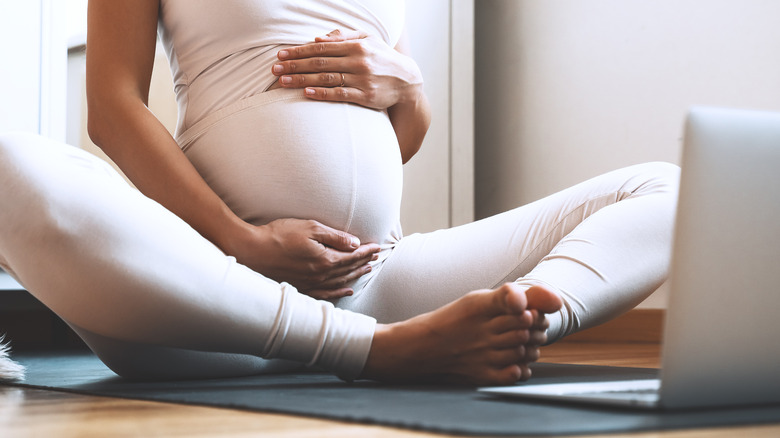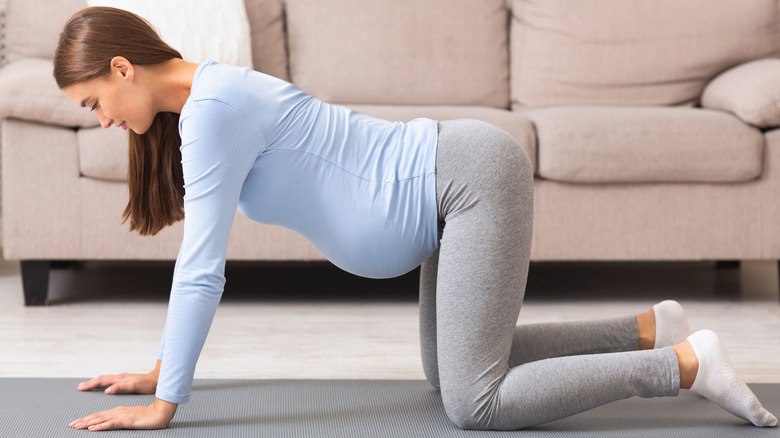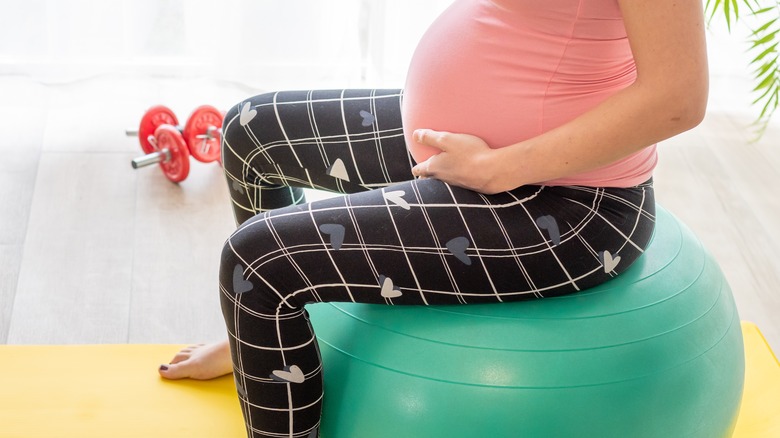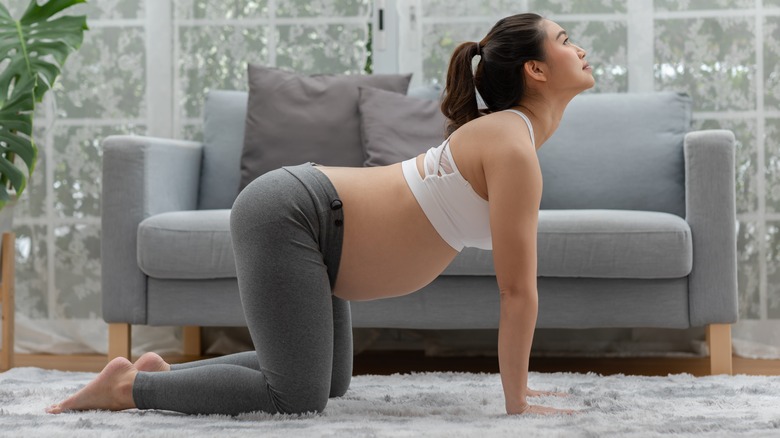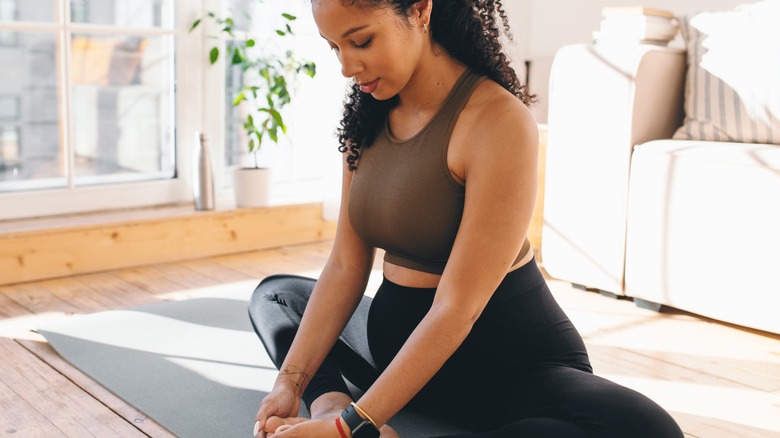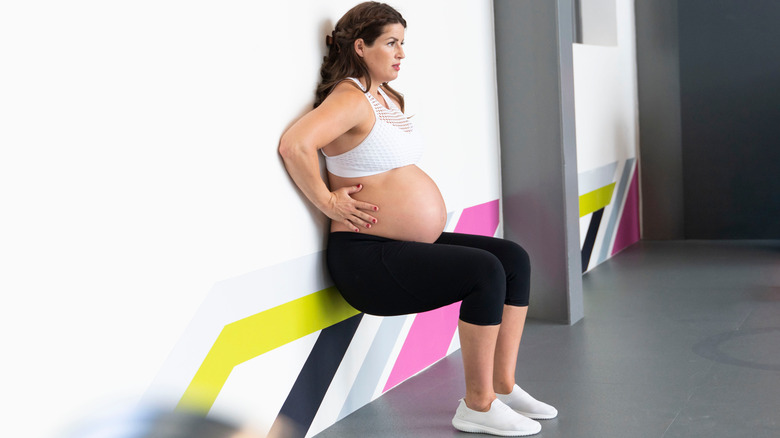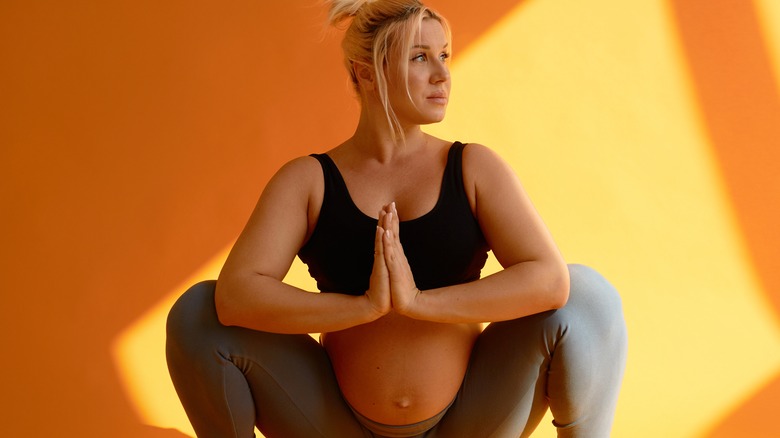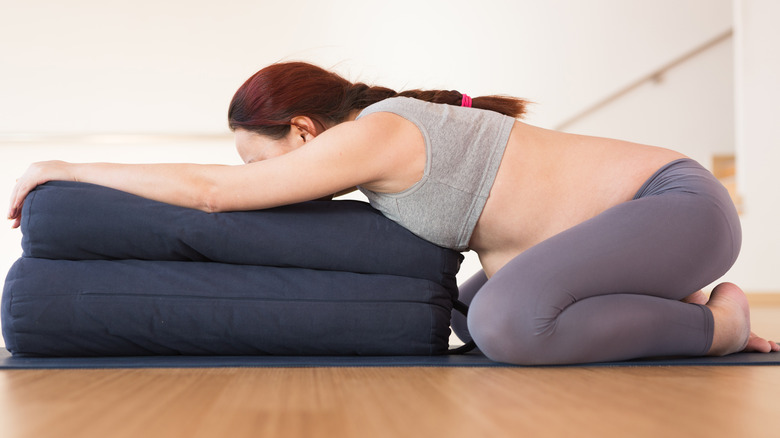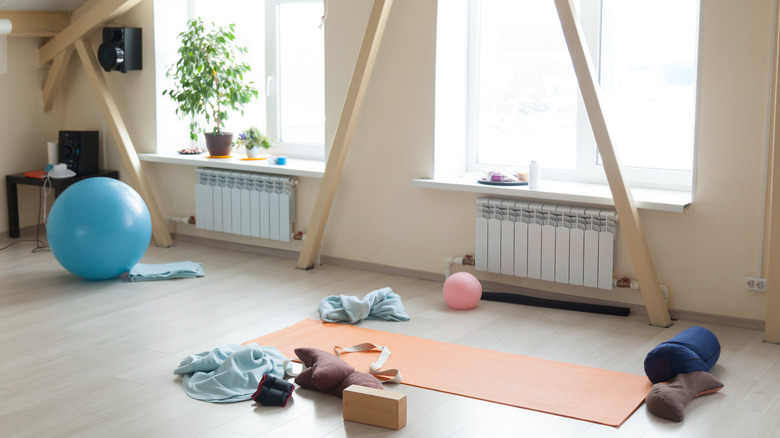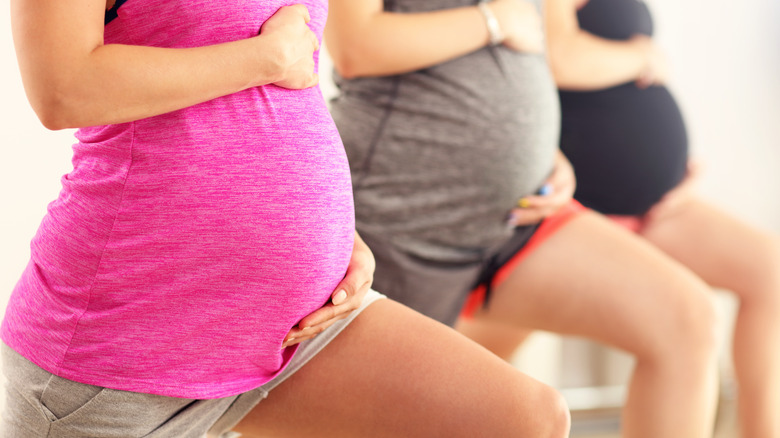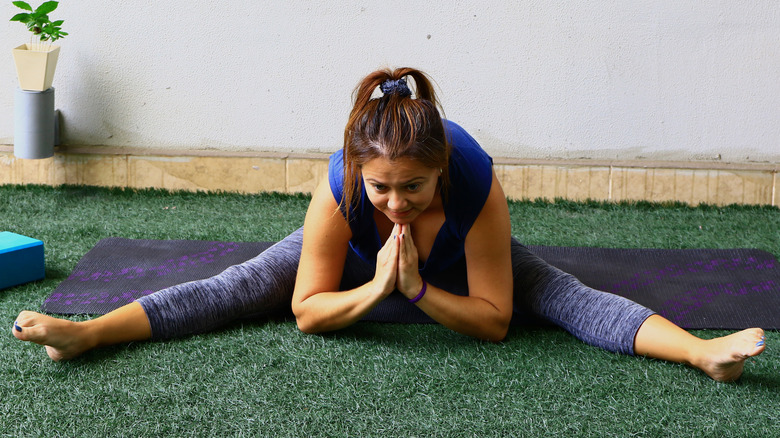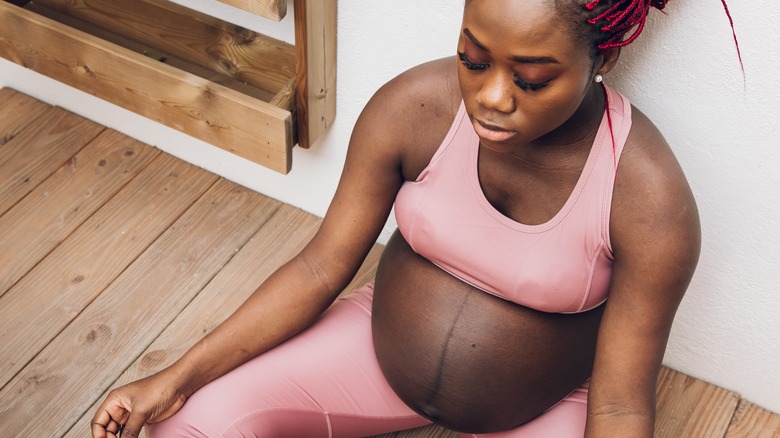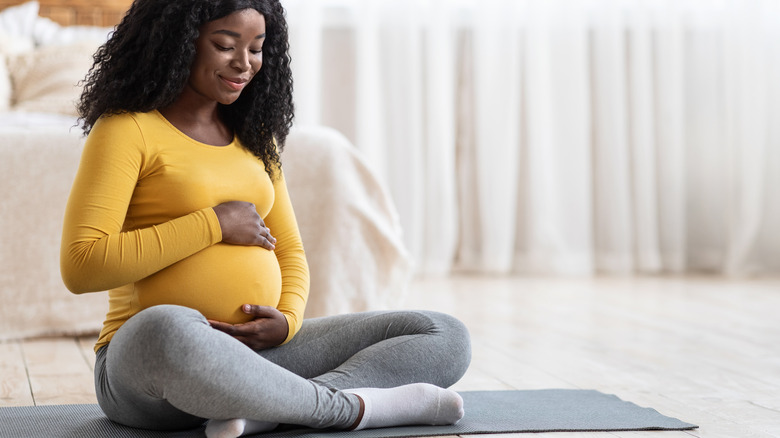The Best Exercises To Help You Prepare For Labor
When preparing for a new baby, it may feel like there is so much to do that you will never feel quite ready. Plus, the anticipation of labor can feel overwhelming — whether it's your first baby or not, every birth is different, and it's impossible to predict exactly how things will go.
Research shows that exercise can help prepare your body for labor in many different ways. In fact, some studies suggest that regular cardio throughout pregnancy can lead to a quicker and less painful delivery, on top of fewer risks for complications (via Aaptiv).
One study published in the American Journal of Obstetrics and Gynecology showed that over 65% of expectant mothers who ran or practiced aerobic activities throughout their pregnancy finished labor in less than four hours. Another meta-analysis (via Reproductive Health) reported that pregnant women who participated in water aerobics were less likely to ask for pain medication during childbirth. Not only that, but there are certain types of exercises that can help prepare your body for the actual task of labor itself. Let's explore some common exercises that can help your body get ready for childbirth.
Types of exercise helpful for labor
According to Aaptiv, when it comes to giving birth, there are two specific muscles groups that are utilized: pelvic floor muscles and the transverse abdominis (TvA). They are put under a lot of pressure during childbirth, which is why it's important to stretch and strengthen them beforehand.
Your pelvic floor muscles span between your tailbone and pubic bone and help control your bowels, bladder, and uterus (via Better Health). Practicing contracting and relaxing the pelvic floor muscles can help prevent them from tearing or needing to be cut during labor (per Aaptiv). Meanwhile, the TvA are the abdominal muscles that help with pushing the baby out, so strengthening these muscles can help with the labor process.
However, Catherine Cram, M.S., told Aaptiv: "I don't want women to think there will be no problem because there are so many things that can go wrong that have nothing to do with whether or not she exercised." All you can do is try your best to prepare and remind yourself that some things are out of your control. Also, be sure to check with your doctor before beginning any exercise routine when pregnant. While working out is generally helpful, everyone is different. For example, those experiencing a high-risk pregnancy may be directed by a doctor to not exercise (via Baby Doppler).
Pelvic tilts
Pelvic tilts can build up the strength in your abdominals, which can help make it easier to push during labor. Strengthening your core muscles also helps reduce your risk of experiencing back pain while pregnant (via Baby Doppler).
Pelvic tilts are commonly practiced while lying down on the floor on your back. However, it's generally recommended to avoid lying flat on your back when pregnant. Instead, experts advocate pregnant people practice this exercise while sitting or kneeling on their hands and knees (via My Baby Manual). Practicing pelvic tilts on all fours seems to be a popular choice, since it's commonly thought to be a helpful posture for motivating the baby to be in the proper position for birth.
To practice on your hands and knees, start with your hands underneath your shoulders and your knees under your hips. Gently tuck your tailbone so that your back slightly hunches and your chin comes to your chest. Stay in this shape for a few deep breaths, then neutralize your spine, returning back to your starting position. You can also practice this exercise while sitting on a birthing ball or fitness ball and scooping your pelvis slightly forward.
Birthing ball exercises
Using an exercise ball — sometimes called a birthing ball when you're pregnant — can be beneficial for many reasons. Pregnant people who have used a birthing ball report that it seemed like they experienced a faster, smoother delivery (via Baby Center). Plus, bouncing up and down on an exercise ball not only comforts your baby, but it can help the baby naturally move downwards. It also supports cervix dilation, which is good if you're nearing your due date (per The Bump). Gently bouncing on a birthing ball is also helpful for your spine and low back, as well as your pelvic floor muscles, since it naturally causes them to relax and contract with the bouncing movement.
You can also strengthen your ab muscles while sitting on an exercise ball by moving your pelvis side-to-side, in circles, or front-to-back, as you would in a pelvic tilt. Just be sure to sit on the birthing ball with your legs far apart from each other as you exercise.
Cat/cow
Cat and cow are a series of two different yoga poses. This movement is similar to the pelvic tilt exercise, with a few more steps added in.
Cat/cow can increase spine movement and circulation in the back, which can help reduce back pain and protect the spine (via Cosmopolitan). Plus, the cat pose requires arching and rounding of the spine, which will be muscle movement you call upon when it's time to give birth (via Postpartum Trainer). Strengthening these muscles can help prepare your body for labor.
To practice cat/cow, begin on your hands and knees, with your hands underneath your shoulders and your knees under your hips. As you inhale, gaze up and move your belly towards the ground, and pause here for one moment, enjoying cow pose. As you exhale, tuck your chin into your chest and pull your spine towards the sky, rounding your back like a scared or stretching cat — this is cat pose. Move back and forth between cat and cow position for 8 rounds of breath, or as long as it feels comfortable to do so.
Butterfly pose
Butterfly is a classic posture that is practiced in yoga. This exercise can help stretch and strengthen your pelvis, back, and thigh muscles, which can help prepare your body for childbirth (via Baby Doppler).
To practice butterfly, begin by sitting on the floor on top of a yoga mat, blanket, or anything that feels comfortable. Bring the soles of your feet together to touch and allow your knees to sink towards the ground with gravity. Slowly push your knees closer to the ground to deepen the stretch in your inner thighs. Make sure to keep the movement slow, static, and steady — try not to bounce your knees into the shape. Remain in the posture for at least 10 seconds, breathing deeply, then release and repeat as many times as you wish.
If you'd like, The Bump suggests trying to move through seated cat/cow spine movements while you have your legs in butterfly pose. Alternate these shapes 5-10 times, or as long as it feels comfortable.
Supported squats
There are two different types of squats that are helpful for preparing your body for labor: a supported squat and a deep squat. A supported squat is more of a workout, helping to tone your glutes and legs while stretching your pelvic floor muscles. According to Melissa Green, a labor support doula and postpartum corrective exercise specialist, you can practice this exercise for up to 5 minutes per day, as long as your baby is in the head down position (via The Bump).
Begin by pressing your back into a wall. If you have low back pain, you might try placing a birthing ball in between your back and the wall to help soothe some of the tension — but keep in mind that this will require a little more work in the balance department. You can always bring a chair next to you to hold on to for extra support. Stand with your feet underneath your shoulders. As you exhale, slowly lower your hips and bend your knees, sliding your back against the wall or ball. Pretend like you are sitting in a chair and only go down as far as feels comfortable. Don't forget to breathe deeply and steadily.
Deep squats
Deep squats are one of the most effective and beneficial exercises for helping your body get ready for childbirth. This exercise helps stretch the pelvic floor muscles, including the perineum, which is the sensitive skin in between the genitals and anus (via UT Southwestern Medical Center). The perineum extends and lengthens during labor to give space for the baby to exit, so stretching it prior to child birth can help this area be prepared for the main event (via Pregnancy, Birth & Baby).
This exercise also helps build up your leg muscles and opens the hips. To practice, you'll want to make sure you have something nearby to hold on to for support, like a chair, table, or counter. Begin by standing with your feet slightly wider than hip-width distance apart and your toes pointing out at a 45-degree angle. Slowly bend your knees and bring your glutes towards the ground. Try to keep your heels pressing into the ground — if you can't, you can place a rolled-up blanket underneath them. Lower as deep as you can comfortably go, while keeping your back straight, and press your palms into one another so that your elbows are nestled into the inside of your knees (per Postpartum Trainer).
Supported forward bend
This movement will help stretch your back, as well as your shoulders and leg muscles. It may also help release tension in your low back (via Baby Center). To practice this exercise, start by standing next to something you can hold onto for support, like a wall, chair, or kitchen counter. Begin with your legs parallel and feet underneath your hips (via The Bump). Press your hands into your prop and pull your hips backwards with a slight bend in your knees. Try to keep your back flat as you hinge at your hips, so that your torso and legs make a 90-degree angle. Relax your neck muscles and gaze softly at the ground below. Press into the wall or counter until you feel a comfortable stretch and stay here for 5-10 seconds, breathing deeply, then return to standing. Repeat this exercise 2 or 3 times if you'd like.
Child's pose
Child's pose is another classic yoga posture which is known to be very relaxing. This pose can help stretch your pelvic floor muscles and ease discomfort felt during childbirth (via Baby Doppler). It also helps open your hips and shoulders while strengthening your back muscles. Child's pose is considered gentle enough to practice during any stage of pregnancy.
To do child's pose, begin kneeling on a comfortable surface, like a yoga mat or blanket. Move your knees wider than hip-width distance apart and keep your big toes touching. Rest your glutes on top of your heels, then slowly start to walk your hands and torso forward, keeping your legs as they are. Look towards the ground as you reach your arms out long and straight, until your torso is close to the ground. Remember to breathe as you are getting into this shape and continue to do so as you stay here for up to 5 minutes, or however long you feel comfortable. If you feel uncomfortable in any way, add in adjustments, like widening your hips more to make room for your belly or placing a blanket underneath your knees or ankles for extra support. It may also feel nice to roll up a blanket and place it in between your legs behind your knees. Make modifications until you feel secure and not strained in the pose (per Baby Med).
Supported supine pigeon stretch
Pigeon pose is a traditional yoga posture that stretches and opens the hips, which can help your body prepare for the big day. It's not recommended for a pregnant person to practice traditional pigeon pose, but a supported supine pigeon stretch is considered safe for pregnancy and will stretch the same muscles (via Oprah). To avoid lying directly on your back, you'll want to gather some props — like several pillows or yoga blocks and a bolster, if you have them — to support your torso and prop it up off the ground.
To begin, sit down on the ground or a bed. Before you lie back, place your props underneath your back so that your torso is at an angle. Bend your knees with your feet flat on the ground. Slowly place your left ankle to rest on top of your right knee. Put your hands on the back of your right thigh, then gently pull your right leg towards you, lifting your right foot off the ground until you feel a stretch in your right glute muscle. Pause here for 15 seconds, breathing deeply, then release. Repeat the same stretch on your left side (per Postpartum Trainer).
Standing hip flexor stretch
Stretching your hip flexors will help prep your body for staying in the child birthing position for as many hours as you'll need on the special day. Your hip flexors are located on the front of your thighs. To practice this exercise while pregnant, you'll want to find a chair or strong box you can step on with a little bit of weight. Place one foot flat on top of your prop and keep your standing leg straight. Slowly and slightly lean forward so that your standing leg is stretched out behind you. You can place your hands on your hips or hold on to a chair or a wall with one hand to help you balance. Avoid arching your back and activate the glute muscles of your standing leg. Pause here for 15 seconds and continue to breathe deeply, then release and return to standing. Repeat the exercise on the other side (via Postpartum Trainer).
Pancake stretch
The pancake stretch, also referred to as a seated wide-leg forward fold in yoga, helps stretch your inner thighs, low back, and hamstrings while opening the hips (per Postpartum Trainer). To practice this stretch, begin seated with your legs straight and toes pointing up towards the sky. Keeping your legs straight, gently widen the distance between your legs until you feel a stretch — it might feel uncomfortable, but shouldn't feel painful. For a deeper stretch, place your hands on the ground in front of you, in between your legs, and lean your torso forward. Pause here for 15 seconds, breathing deeply, then release.
Baby Med recommends placing blankets or pillows in front of you as you lean forward to rest your belly on. The support from the props should help reduce any strain or tension you might feel in your back from this pose. You may also try sitting on a folded blanket to encourage a natural tilt of your pelvis and make this pose feel more accessible.
Pelvic floor exercises: kegels
Kegels are one of the best ways to strengthen your pelvic floor muscles, which will not only get your body ready for labor, but ease the recovery process afterwards as well (via Kaiser Permanente). Kegels can help train your body to make pushing during labor both easier and faster (per Baby Center). They are so effective that some medical experts recommend practicing them every single day while you are pregnant.
To practice kegels, you'll first need to locate your pelvic floor muscles. The easiest way to do this is to think about the action you would take to stop peeing — like contracting the muscles around your vagina and urethra. You can even practice while going to the bathroom until you get the hang of it.
To do kegel exercises in preparation for childbirth, practice contracting your pelvic floor muscles for about 3 seconds, then relaxing for 3 seconds. Do 10-15 repetitions, at least 1 to 3 times per day. Since this exercise is discreet, you can practice them anytime and anywhere.
Breathing exercises
Breathing exercises may seem obvious or unnecessary, but they are very important in preparing for labor. Learning and practicing how to breathe deeply and intentionally will help you do the same during childbirth. It can be especially helpful to practice in moments of pain or stress to train your body and mind to remain calm and breathe deeply when going through a difficult time (via Baby Center).
To practice mindful breathing, remain still, bring your attention to your breath, and close your eyes. Slowly inhale through your nose and exhale deeply with your mouth, maybe even sighing it out. Imagine any body tension you feel relaxing and releasing every time you exhale.
It might help to place your hands on your belly and chest, to visualize your breath going all the way down to your lower diaphragm. "Sit up straight, put your right hand on your belly (baby) and put your left hand on the heart centre (the middle of the chest), then breathe from the belly to the chest," yoga teacher Nadia Narain told Cosmopolitan. "On your exhale, feel the belly soften back towards you."
